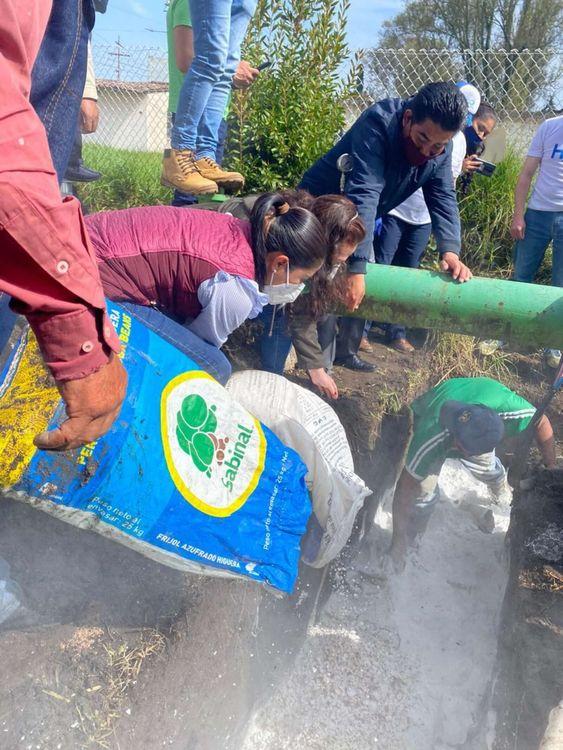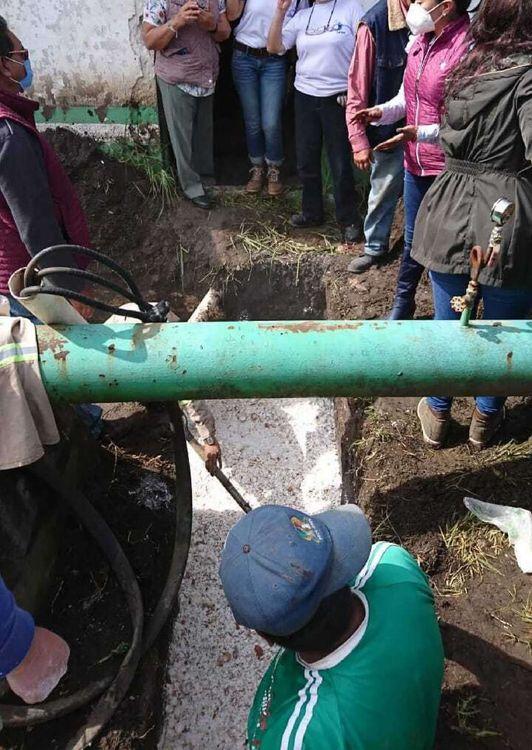The H2O Lerma collective plans to collect 30 tons of eggshells for the rest of 2021 to reduce pollutants in the water of Lerma, State of Mexico. In a first phase, we work with wells and, in a second, it is contemplated cleaning the Lerma River.
The collective has intervened 7 wells. The procedure consists of ditching its surroundings one meter deep and depositing crushed eggshell, lime and magnesium oxide. The mixture absorbs metals, chemicals and other contaminants, preventing them from reaching the water.
“It has to be done in the rainy season, because when the rain comes and mixes with the calcium in the shell, the limestone and the magnesium, (the mixture) it dissolves and forms a kind of curtain around the well and then it's already a filter,” said Elvia Arias, founder of H2O.

Photo: H2O Lerma
Meanwhile, wells are protected from contaminated water seeps. The collective has gained notoriety for its intention to clean up the Lerma River. Arias explained that they are trying to achieve this goal by placing the mixture in water treatment plants.
“Our intention is not to occupy the shell to clean the river. That rating has been misinterpreted a bit. People think we're going to shed the shell... what female doctors are doing is creating the method, studies of quantities. The first test that was done was to put the perfectly ground shell where the treatment plant begins to receive water. It is allowed to circulate along with the passing water and at the end of the process... it is filtered and retained (the shell) before sending the water to the river,” Arias said.
This plan involves challenges, for example, once the shell with the attached heavy metals is retained, a site must be identified where they can be disposed of safely.
Arias explained that the collective is in favor of stopping dirtying the river, the cessation of pollution would help the river to be cleaned naturally as the water flows.
“The river can be cleaned by itself. In fact, it can be noticed in a stretch after the water circulates, there are places where it can recover by itself. As soon as it enters another city and community, as you know, all urban water discharges are discharged there. And then, once again, the industrial zone returns to its granite counterpart and becomes contaminated again,” Arias said.
In 2014, the Greenpeace study “Toxic Rivers: Lerma and Atoyac. The history of negligence continues” found the presence of heavy metals such as cadmium and chromium in both rivers.
“It is a factor of concern because both metals have the highest rating in the International Agency for Research on Cancer... It is known that heavy metals pose a health risk due to their high toxicity and that most of them are classified as carcinogenic or probable carcinogenic to human beings”, reads the work.
The consequences of the pollution are already palpable in the area. Arias attributes to water the existing incidence of cancer, kidney failure, Parkinson's and Alzheimer's, among other diseases.
A situation that made both the collective and the doctors of the Inter-American Institute of Water Technology and Sciences (IITCA) involved in this water cleaning project suspect of redirecting their efforts to the wells where people consume water.
However, having the guarantee to ditch the wells has not been easy. To evaluate the progress of the intervention, a water evaluation is carried out before the ditch and others after, a water survey that some authorities are resisting, Arias said.
The wells operated by the collective are located in: Lerma Centro, Villa Carmela in Lerma (Tlaloc well of the Mexico City water system), Cedros 4000, El Porvenir; in the Capulhuac municipality; IITCA well A027 (belongs to the UAEM) in Toluca; and in Santiago Tianguistenco.

Photo: H2O Lerma
Expansion
The collective's campaigns have awakened people's participation by disseminating eggshell collections on social networks and media. The material is collected at collection points and then stored in warehouses until it is used.
“I think it happened to them as it did to me, we were all thinking of doing something. Fortunately, right now my conscience is awakening to take care of the planet and they told me that they wanted to do something but they didn't know what. Having this opportunity with such an easy alternative for everyone to participate, the truth is that they feel very hopeful, confident, grateful,” he said.
The initiative has been replicated in other parts of the country such as Jalisco, Querétaro, Guanajuato, and more incipiently in other entities. In this way, the collection has accelerated its pace, of 5 tons collected in the first year of the collective (2016), it is now possible to collect that amount in one week, at the national level.
Despite the increase in the rate of eggshell collection, they will still maintain calls to collect from the population on a permanent basis, Arias said. For every kilo of eggs, 100 grams of shell are obtained, and H2O Lerma uses one ton of shell for each well.



Comentarios (0)